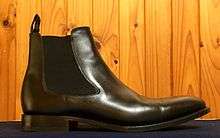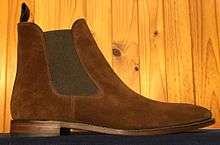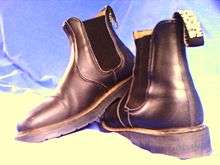Chelsea boot


Chelsea boots are close-fitting, ankle-high boots with an elastic side panel. They often have a loop or tab of fabric on the back of the boot, enabling the boot to be pulled on. The boot dates back to the Victorian era, when it was worn by both men and women.
Chelsea boots and some of its variants were considered an iconic element of the 1960s in Britain, particularly the mod scene.
History

The design is credited to Queen Victoria's shoemaker J. Sparkes-Hall.[1] The shoemaker certainly claimed it as his own, patenting the design in 1851 and citing his royal wearer, saying: "She [Queen Victoria] walks in them daily and thus gives the strongest proof of the value she attaches to the invention".[2] In his advertising of the period, he refers to the boot as J. Sparkes-Hall's Patent Elastic Ankle Boots.[3] The boot became popular for horse riding as well as walking.[2]
Charles Goodyear's development of vulcanised rubber enabled the invention of the elastic gusset boot. The advantage of elasticised boots meant they could be easily removed and put on again. By the late 1840s, the fashion began to catch on. This became a prominent style in the West until the onset of World War I.[4]
In the 1950s and '60s, Chelsea boots became popular in the UK – and their association with the King's Road (a street in Chelsea and Fulham in inner western London) set of Swinging London – worn by everyone from the Rolling Stones to Jean Shrimpton – is believed to explain how the name "Chelsea" became attached to the boot.[2][3]
Variations & similar styles

Beatle boots
Theatrical and ballet shoe maker Anello & Davide created a variant of the Chelsea boot in 1961 with cuban heels and pointed toes for The Beatles, after John Lennon and Paul McCartney saw some Chelsea boots in its shop window and commissioned four pairs with higher, Cuban heels – this style became known as Beatle boots.[5]
Beatles boots, as were Chelsea boots, were frequently adopted by mods and worn with tailored suits.[3]
Other variations
Some modern versions of the boot have a side zip rather than an elastic panel.[2]
Variants and similar boots include a type of riding boot called jodhpur boots as well as assorted work boot designs, including Australian work boots like those manufactured by Blundstone and other companies: such work boots may have steel toes.
See also
References
- ↑ staff (27 November 2012). "The perfect Chelsea boot". Esquire. Retrieved 13 July 2014.
- 1 2 3 4 staff (2 March 2011). "The Edit: Chelsea Boots" (2/5). Mr Porter. Archived from the original on June 28, 2013. Retrieved 13 July 2014.
- 1 2 3 Nanjappa, Vikram. "The Chelsea Boots Guide". gentlemansgazette.com. Gentleman's Gazette. Retrieved 13 July 2014.
- ↑ Kippen, Cameron. "The History of Boots". Department of Podiatry. Perth, Western Australia: Curtin University. Archived from the original on 2007-08-12. Retrieved 2013-09-21.
- ↑ Bramwell, Tony (2004). Magical Mystery Tours: My Life with the Beatles. Robson. p. 34. ISBN 0-312-33043-X.